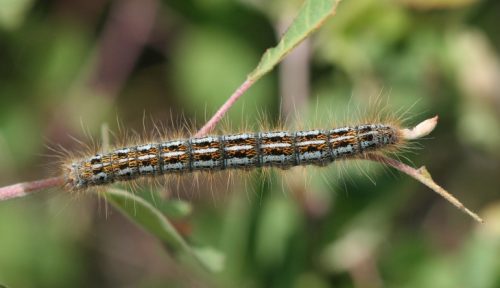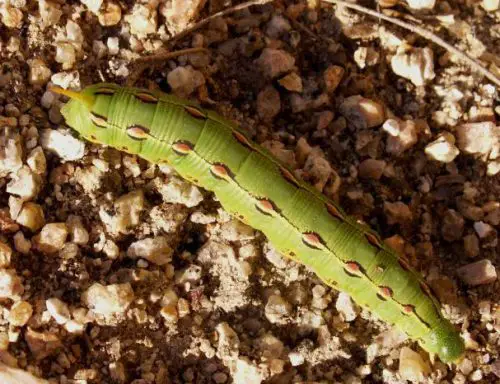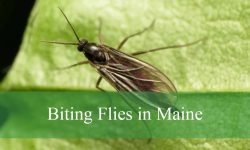All types of Arizona caterpillars are usually large with cylindrical bodies. These crawling insects are a nuisance to backyard gardeners since they defoliate crops, trees, and landscaping shrubs during the monsoon season.
Native Arizona caterpillars come in different sizes and colors for easy identification. But many people find it challenging to recognize them due to their appearances. Here is a comprehensive list of Arizona caterpillars with their descriptions and pictures.
Are Arizona Caterpillars Poisonous?
Native Arizona caterpillars can be poisonous and non-poisonous. Brightly colored and hairy caterpillars in Arizona are venomous since they have toxic glands or feed on plants with toxic substances.
Poisonous Arizona caterpillars do not bite since they are non-aggressive. But their spikes can cause nasty skin rashes and pain when they break into the human skin. Refrain from handling these caterpillars to avoid skin irritation.
Non-poisonous caterpillars in Arizona have smooth bodies. But furry Arizona caterpillars can cause skin irritation if they come into contact with human skin. Burning sensation and skin inflammation are the other prominent symptoms.
Exercise precaution when collecting litter in your yard, parks, and river banks since there is a high chance of spotting these crawling insects. Be sure to wear protective gear if you’re not sure whether the caterpillar species sting or not.
Different Types of Arizona Caterpillars
Arizona has over a hundred caterpillar species with different colors and sizes. Here is a list of 20 Arizona caterpillar types with their descriptions and pictures:
Cabbage Looper

It is a green caterpillar type with a pale-yellowish green head and yellow bands separating each segment. The species is harmless to humans or pets due to its smooth body.
The crawling insect arches its back to form a loop while in motion. The yellow bands change color in different growth stages.
The green cabbage lopper feeds on cabbage leaves and bores holes in the cabbage heads. They can grow up to 30-44mm long during the wet summer.
Scientific Name |
Trichoplusia ni |
Host Plants |
Cabbages and Kales |
Identification Features |
Faint yellowish markings and looping motion. |
Viceroy Caterpillar

It is a butterfly caterpillar with a strange brown appearance and mottled white markings at the middle segment. These caterpillars dwell on willow and cottonwood trees.
The unique bumps, dotted markings, and spiked protrusions are the distinctive features for easy recognition. These grubs look like bird droppings in the first growth stage.
Mature viceroy caterpillars are orange-brown with white spiny humped and grow up to 15mm long. They are harmless and non-stinging due to the lack of tufts of irritating hair.
Scientific Name |
Limenitis archippus |
Host Plants |
Willow and cottonwood trees |
Identification Features |
Orange-brown bumpy caterpillar |
Black Swallowtail

It is a bright green caterpillar with yellow bands and black markings. The striped green caterpillar can grow up to 40mm long.
Juvenile black swallowtail caterpillars usually have black and white colors. The Arizona black swallowtail caterpillars are poisonous to small birds and rodents.
The toxins in the caterpillars develop from the plants they eat. But venom is not much to kill a human being.
Scientific Name |
Papilio polyxenes |
Host Plants |
Carrots, dills, parsley, and fennel |
Identification Features |
Black and yellow patterns on its body |
Monarch Caterpillar

The striped butterfly caterpillar has black, white, and yellow patterns around its abdomen. The fleshy horns on both ends and stripy abdomen are distinctive features.
The Arizona monarch caterpillars are harmless and grow up to 45mm long. These crawling insects are poisonous to birds and predators due to their diet.
These plump caterpillars feed on milkweed plants that create toxins in their bodies. The toxins make these grubs taste nasty to birds and other insects.
Scientific Name |
Danaus plexippus |
Host Plants |
Milkweed plants |
Identification Features |
Black, yellow, and white stripes |
Tobacco Hornworm

The tobacco hornworm is also called the goliath worm due to its enormous body. The crawling insect has diagonal white stripes and black dots along its abdomen sides.
The tobacco hornworm is a type of horned caterpillar due to its rosy-pink curved horn-like tail and distinctive curled head. The moth caterpillar grows up to 70mm long.
The tomato hornworm is related to the tobacco hornworms though they have different markings and sizes. A tomato hornworm is 100mm long and has V-shaped patterns.
Scientific Name |
Manduca sexta |
Host Plants |
Tobacco leaves |
Identification Features |
Pale green body with pale white and black lateral markings. |
Cecropia Moth Caterpillar

It is a moth caterpillar in Arizona with a scary appearance. The bluish-green caterpillar has orange, yellow, and blue ball-like spiked tubercles around the ridged segments.
The wide head section and bluish tubercles on the eight prolegs are additional distinctive features for easy identification. It can grow up to 100-110mm long.
The scary-looking caterpillar changes to yellowish-green from spiky black throughout the growth stages. The spikes can cause skin irritation and pain upon touching.
Scientific Name |
Hyalophora cecropia |
Host Plants |
Ash, birch, alder, elm, willow, and apple |
Identification Features |
Bluish-green body with yellow, orange, blue, and red spiked tubercles. |
Crowned Slug Caterpillar

The Arizona caterpillar has a flattened oval body covered in stinging spines. The yellow venomous spines can cause skin irritation and nasty rashes.
The green-stinging caterpillar also has red or yellowish margins and two protruding yellow lines on the back. The grub can grow up to 15mm long.
The crowned slug caterpillars love feeding on the leaves of cherry, apple, birch, elm, ashes, and oak. Use chemical treatment to eliminate them and save your backyard trees.
Scientific Name |
Isa textula |
Host Plants |
Elm, cherry, apple, maple, oak, ash, and birch |
Identification Features |
Yellow spiny protrusion around its green body. |
Western Tent Caterpillar

It is a slender furry caterpillar that resembles a worm. The crawling insect body is covered in orange or dark yellow tufts of fine setae. (Source: University of Arizona).
The tent-like web structure is the reason for the name of this black and orange caterpillar. The furry Arizona caterpillar can grow up to 50mm long.
These caterpillars live in colonies underneath the host plant’s leaves. These leaf-destroying bugs can pose a threat to your ornamental trees or shrubs.
Scientific Name |
Malacosoma californicum |
Host Plants |
Bitterbrush, wild rose, ninebark, and mountain mahogany. |
Identification Features |
Striking orange stripe and wispy orange hair covering the black body. |
Yellownecked Caterpillar

It is a black and yellow striped caterpillar that loves feeding on the leaves of birch, oak, and other hardwood trees. The caterpillar can grow up to 50mm long.
The orange throat and bulbous black head are the distinctive features for easy identification. The wispy spines give these Arizona caterpillars a fuzzy appearance.
Scientific Name |
Datana ministra |
Host Plants |
Birch, oak, and other hardwood |
Identification Features |
Yellow stripes running from the head to the tail of this black hairy caterpillar |
Variegated Fritillary Caterpillar

It is a beautiful orange or red Arizona caterpillar with several branched black spines. It also has prominent rows of oval, bright white dots, and brown-black legs.
Pair of clubbed spines on the thorax and prolegs are other distinctive features for identifying variegated fritillary caterpillars. These caterpillars grow up to 90mm long.
Scientific Name |
Euptoieta Claudia |
Host Plants |
Passion vines, mayapple, flax, and purslane |
Identification Features |
Orange caterpillar with longitudinal white and black stripes along its tubular body. |
Common Buckeye Caterpillar

It is a black spiny caterpillar with orange patterns and an orange head. The several color variations make it challenging to identify them.
Some species have a spiky black appearance with white stripes and brown markings, while others lack stripes though covered in tiny white speckles.
The spiky black caterpillar grows up to 40mm long with fleshy tufts of spines along its body. These crawling insects love feeding on plantain, false foxglove, and passion vines.
Scientific Name |
Junonia coenia |
Host Plants |
Plantains, false foxglove, and monkey flowers |
Identification Features |
Dark-blue or black branched spines, lime-green stripes, and orangey-brown spots. |
Giant Swallowtail Caterpillar

It is the largest butterfly caterpillar in Arizona and North America. The strange-looking brown caterpillar has mottled black, white, and brown markings.
The larva also look-like a bird dropping to help camouflage on tree and shrub branches from potential predators. The caterpillar can grow up to 50mm long.
Scientific Name |
Papilio cresphontes |
Host Plants |
Citrus, lime, prickly ash, and hoptree |
Identification Features |
Large brow caterpillar with white and dark brown patterns. |
Polyphemus Moth Caterpillar

It is a bright green silkworm with delicate spines sticking out from the red dots along its abdomen. The cigar-shaped caterpillar can grow up to 75-100mm.
The neon-red dots are conspicuous features for easy identification. Other features are the fat green body and spiky appearance.
Scientific Name |
Antheraea polyphemus |
Host Plants |
Apple, ash, elm, hazel, hickory, maple, rose, and willow. |
Identification Features |
Neon red dots with delicate spines on the bright green body. |
Banded Woolly Bear Caterpillar

The black fuzzy Arizona caterpillar is easily recognizable due to the brown-orange bands around the middle. The caterpillar can grow up to 50mm long.
The black and orange furry caterpillar does not sting despite having the hairs. The tufts of hair do not cause skin irritation and pain to humans.
But people with skin allergies might experience dermatitis from the sharp spines. Be sure to refrain from handling these caterpillars.
Scientific Name |
Pyrrharctia isabella |
Host Plants |
Plantain, dandelion, dock, aster, goldenrod, and some grasses. |
Identification Features |
Furry black and a brown body. It can also roll into a ball when feeling threatened. |
Red Admiral Butterfly Caterpillar

It is a butterfly caterpillar with a black body covered in fleshy black branched spines and tiny white spots. The black spiky caterpillar changes its body size throughout its instars.
The caterpillar grows up to 25mm long and turns dark brown with thin black jagged spines. The spikes can cause skin irritation and nasty rashes upon handling.
Scientific Name |
Vanessa atalanta |
Host Plants |
Stinging nettle plants |
Identification Features |
Shiny black body with spiny spike bands |
Silver-Spotted Skipper Caterpillar

It is a type of yellow caterpillar with thin green bands around each segment and a prominent ball-like reddish-brown head.
The bright orange eye spots, bright red throat, and red feet are the distinctive features of silver-spotted skipper caterpillar identification.
The caterpillar loves feeding on the foliage of black locusts before pupation. It can grow up to 50mm long.
Scientific Name |
Epargyreus clarus |
Host Plants |
Black locust |
Identification Features |
Orange eye spots, bright red throat, and feet. |
Spotted Tussock Moth Caterpillar

It is a type of yellow and black caterpillar also called a yellow woolly bear. The crawling insect can grow up to 30mm long in wet summer.
The prominent tufts of long pencil hairs and yellow bands with a row of black dots are the distinctive features for easy identification.
These larvas love feeding on the foliage of poplar, willow, birch, oak, and maple trees. I recommend inviting backyard birds to help in controlling these pests’ populations.
Scientific Name |
Lophocampa maculata |
Host Plants |
Willow, birch, oak, poplar, and maple trees |
Identification Features |
Long white pencil hairs sticking out from the yellow hairy caterpillar’s body. |
Southern Flannel Moth Caterpillar

It is a type of hairy stinging caterpillar that hails from Arizona State. The brown caterpillar has a deceptive appearance to hide from potential predators.
The fluffy hairs usually hide the tiny stinging spines to create a deceptive soft-looking. I recommend refraining from touching or handling these grubs.
The southern flannel moth caterpillars thrive in a hot and dry environment. These caterpillars are also called puss moths, fire caterpillars, and woolly slugs.
Scientific Name |
Megalopyge opercularis |
Host Plants |
|
Identification Features |
Curly golden brown hairs cover the teardrop-shaped body. |
Two-Tailed Swallowtail Caterpillar

It is an Arizona butterfly caterpillar with a two-tailed swallowtail. The plump caterpillar has a humped back and prominent eyespots on its head.
The tiny dots bands traversing the segments are also distinctive features for identifying and classifying this caterpillar species. It has a slightly conical body shape.
Other identification features are pale white blotches, large heads, and yellow faces among immature species. Juvenile species usually look like bird droppings on the branches.
Adult caterpillars are usually reddish with a black rim behind the enlarged head. The horn-like structure appears when the caterpillar is threatened.
Scientific Name |
Papilio multicaudata |
Host Plants |
Chokecherry, bitter cherry, rosewood, hoptree, and Arizona sycamore |
Identification Features |
Broadhead and neck with small eyespots. |
White-lined Sphinx Moth Caterpillar

It is a lime-green or yellow-green caterpillar with black markings and stripes. It also looks like a long plump worm-like insect.
A small brownish head and a fleshy horn-like tail are among the distinctive features for identifying a white-lined sphinx moth caterpillar in Arizona.
These yellow-green striped caterpillars change their colors during the monsoon season in Arizona. They feed in colonies around the swimming pools, gardens, and hiking trails.
The white-lined sphinx moth caterpillars are harmless to humans and turn into attractive brown and pink moths after pupation.
Scientific Name |
Hyles lineata |
Host Plants |
Apple, evening primrose, and fuchsia |
Identification Features |
Lime-green or yellow-green tube-like body with black stripes along the back and sides. |
Related Articles:






